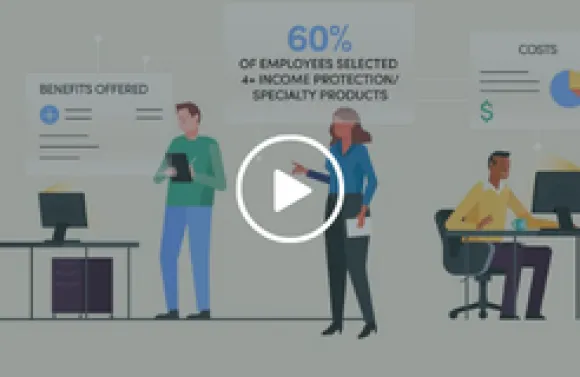If the last 18 months proved anything, it’s that resilience and flexibility are necessary. Not only did a worldwide pandemic disrupt our lives, but it tested and reinforced the things we consider important when taking care of our families. That has led many employees to exploring and redefining their professional priorities. At the same time, they’re becoming increasingly savvy consumers of health care. Combine that with a rebounding (and remote) job market, and employers are facing unprecedented challenges in recruiting and retaining top talent.
The Great Resignation
According to Prudential’s recent Pulse of the American Worker Survey, employees are more open to jumping ship as a result of the pandemic:
- Nearly 25 percent reported that they’re planning to find a new job once the fallout from the pandemic settles.
- 48 percent have thought about changing their careers
- 53 percent reported that they would retrain in a completely different field or industry1
The outlook could look grim for employers trying to recruit and retain top talent.
Moreover, a flexible work schedule was listed as the number one value-added benefit for 56 percent of employees while 63 percent reported an expectation of expanded benefits to help them feel secure at the workplace.2 And somewhat surprisingly, HR Executive reported that 64 percent of employees said they would choose a permanent work-from-home option over a $30,000 pay raise.3
These numbers point towards the fact that employees are worried less about once-important loyalties and are more serious about specific aspects of their careers: interest and passion, salary, workplace flexibility, and total compensation including benefits. In short, employees are learning towards employers that support their holistic health and wellbeing. That includes the ability to care for and protect themselves and their families – from wherever they want at any given time. But not all employers can offer remote work as a possibility. So, how can companies differentiate themselves to attract and retain onsite employees and remote workers?
Voluntary and Ancillary Benefits
Voluntary and ancillary benefits are key in employee value proposition, with 94 percent of large employers agreeing that they’ll continue to hold great importance in their total rewards strategy.4 According to the 2020 Aflac Workforces Report, 50 percent of employers reported that a benefits package that included robust voluntary and ancillary benefits helped with employee recruitment and 60 percent reported that it helped with employee retention.5
The types of voluntary benefits being offered – and corporate perks for that matter – are what we could see evolve as the pandemic redefines priorities for employees and employers find new ways to focus on the holistic wellbeing of their workforce.
Here are some examples of voluntary benefits and corporate benefits that are growing in popularity:
Focus on Health
Historically, employee benefits have mainly been thought of as coverage for physical wellbeing – doctor visits, emergency room, surgeries, etc. However, with continued growth in the understanding of everything that impacts employee health, that definition no longer seems comprehensive enough.
For example, Wellbeats recently published a study that explored the evolving understanding of employee health and noted that “a refocus on health should extend into emotional wellbeing, nutrition, and meditation, as well a physical fitness”.6 Here's a look at how employers can expand health benefits beyond traditional health care coverage:
- Offer new mental health benefits: More than half of Americans currently rely on their employers to provide health care benefits that support their whole health and family wellness by offering mental health benefits as a part of their total compensation.7
- Expand virtual care and telehealth benefits: 85 percent of Americans said telehealth has made it easier to get the care they need, and 31 percent of Americans said their health care costs have decreased since using telehealth, making telehealth a quickly expanding and valuable part of health care benefits packages.8
- Encourage healthy diet and exercise: 80 percent of employers report that wellness programs reduce long-term health care costs. Over three-quarters of employers also say that employee wellness also improves employee absenteeism/presenteeism, attracts and retains top talent and works to maintain or improve employee morale.9
Financial Fitness
Financial wellness was a key focus pre-pandemic as employers looked to provide protection against things like rising health care costs and student loans. Rightfully so as Aflac reports that 48 percent of employees couldn’t pay $1,000 or more for out-of-pocket expenses without relying on debt or credit if an unexpected serious illness or accident occurred today.10
It’s no surprise that employees are worried about finances. They can be devastating when you think about everything an unexpected event – like the pandemic – can impact: childcare, job loss, savings, etc.
Employers are increasingly adding, or considering, benefits to provide that financial security blanket for employees:
- Offer daily pay benefits: Employers are reducing turnover by an average for 50 percent while filling open positions 52 percent faster by adding opportunities like Earned Wage Access that provides employees access to earned money before payday.11
- Support care givers: One in five employees report that they’re caring for a family member, while nearly half of employees report that they’re not getting the support they need from employers.12 Offering resources like Cariloop can close the gap in employee-care giver support, creating trust and an attractive employment opportunity.
- Enable health care savings: With the implementation of tools like Rx Insights, employers can help employees save on costly prescription drugs automatically, positioning themselves as a forward-acting health advocate for employees while realizing up to a 15 percent reduction in Rx costs.13
Lifestyle
According to the Benefitfocus State of Employee BenefitsTM 2021 report, employee enrollment in pet insurance and identity theft protection increased significantly since 2018.14 Looking for more than just standard medical benefits, 87 percent of employees say they are loyal to organizations that help them balance work and life15.
With life changing over the past year and a half, there are other emerging benefit options and corporate perks that employers are/can use to attract talent, including16:
- Enhanced PTO and vacation time programs and more flexible holidays to better support and meet unique employee needs
- Paid relocation expenses and/or sign-on bonuses as part of the effort to show that the employer is committed and excited to work with an employee
- Reimbursement or a stipend for equipment costs for remote work to remain competitive and attractive to top talent in the evolving professional landscape
Employers have the opportunity to prove themselves in the employment market with clever and strategic benefits planning. Robust health plan offerings are only the foundation of novel employee benefits packages. Employers have to add or expand voluntary and supplementary benefits that address unique and specific needs as part of their holistic approach to bolstering total compensation and improving employee health. A strategy that includes flexibility, support, protection and opportunity can help differentiate employers in this employee-driven market to recruit and retain top talent.
Read more about the post-pandemic voluntary benefit trends in the latest reports from our State of Employee Benefits series.


